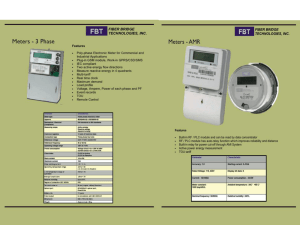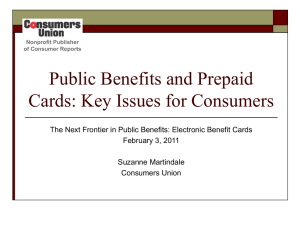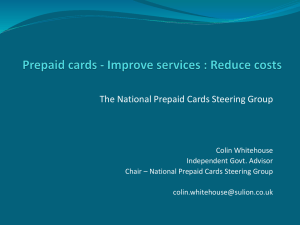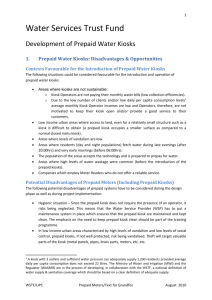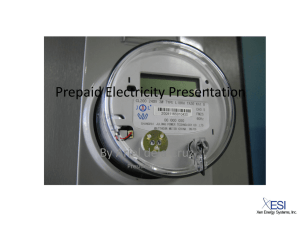11.2 Disadvantages of prepaid yard taps
advertisement
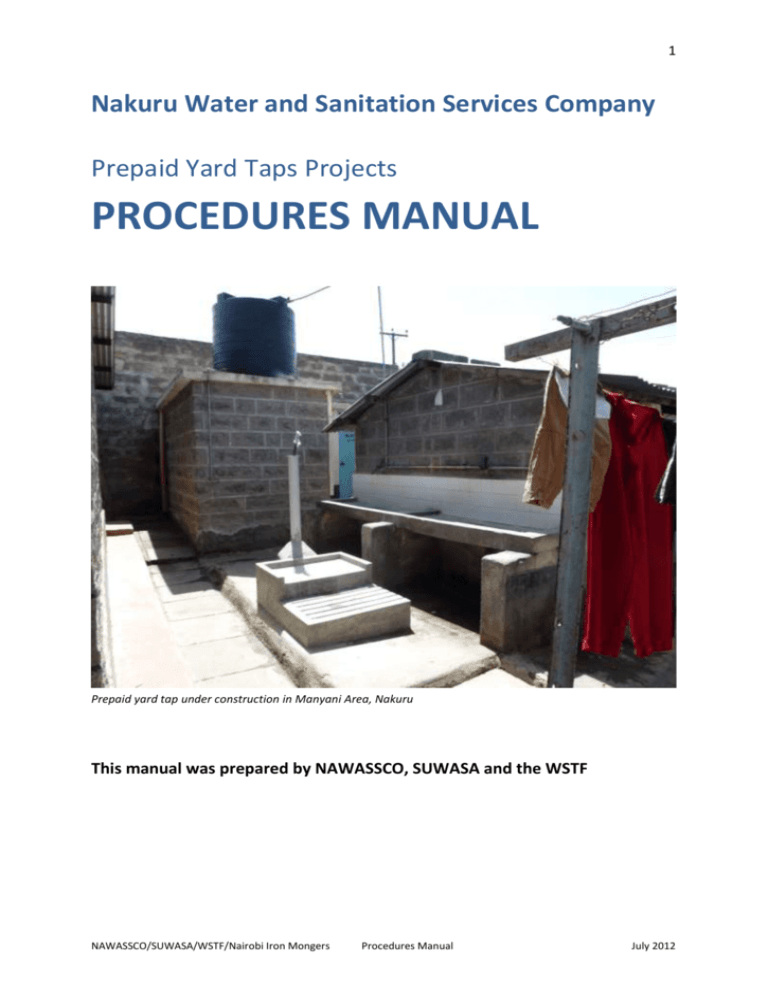
1 Nakuru Water and Sanitation Services Company Prepaid Yard Taps Projects PROCEDURES MANUAL Prepaid yard tap under construction in Manyani Area, Nakuru This manual was prepared by NAWASSCO, SUWASA and the WSTF NAWASSCO/SUWASA/WSTF/Nairobi Iron Mongers Procedures Manual July 2012 2 1. Table of Contents 1. 2. Introduction........................................................................................................................ 5 1.1 About this Document................................................................................................... 5 1.2 Background & Scope of the Nakuru Prepaid Meters Pilot Project.............................. 5 Supplying Low Income Urban Areas: Objectives of WSPs ................................................ 6 PART A: 3. 4. Project Implementation ............................................................................................ 7 Project Task Team, Project Activities & Meetings ............................................................. 7 3.1 Composition of the Project Task Team ....................................................................... 7 3.2 Main Tasks of the Project Task Team .......................................................................... 7 3.3 Project Activities & Project Task Team Meetings ........................................................ 7 3.1 Importance of Good Communication .......................................................................... 8 3.2 Designing the Work Plan ............................................................................................. 8 3.3 Role of the WSTF Field Monitors ................................................................................. 8 Data Collection ................................................................................................................... 8 4.1 MajiData.......................................................................................................................... 8 4.2 The Short Household Survey ........................................................................................... 8 5. 6. Project Planning ................................................................................................................. 9 5.1 Identification & Selection of plots ............................................................................... 9 5.2 Selection of Appropriate Yard Tap Sites .................................................................... 10 5.3 Achieving Cost Recovery? No. of Persons/Prepaid Yard Tap .................................... 10 Project Implementation ................................................................................................... 11 6.1 Creating Awareness within the WSP ......................................................................... 11 6.1.1 Main awareness activities .................................................................................. 11 6.1.2 Awareness creation activities............................................................................. 12 6.2 Sensitization & Education of Users............................................................................ 12 6.2.1 Identification of the target groups ..................................................................... 12 6.2.2 Key messages ..................................................................................................... 13 6.2.3 Media: Posters .................................................................................................. 13 6.2.4 Media: Barazas .................................................................................................. 14 6.3 Informing the Local Authority ................................................................................... 15 6.4 The Customer Awareness & Education Programme ................................................. 15 6.5 Technical Works......................................................................................................... 15 NAWASSCO/SUWASA/WSTF/Nairobi Iron Mongers Procedures Manual July 2012 3 6.6 Need for Metering ..................................................................................................... 17 6.7 Mainstreaming Activities ........................................................................................... 17 6.8 Prepaid Meter, Customer & Project Databases ........................................................ 17 6.9 Hardware, Software and Training ............................................................................. 18 6.10 Embedding of Prepaid Meters in WSPs operations .................................................. 18 6.11 The Project Challenges Logbook ................................................................................ 19 6.12 Recharging Tokens (Nakuru & Kampala) ................................................................... 19 PART B: Project Operation .................................................................................................... 20 7.1 Emphasis on Project Operation .................................................................................... 20 7.2 Creating a lasting presence in the LIAs ..................................................................... 20 7.3 Operation & Maintenance (who does what?) ............................................................. 21 7.4 Importance of Good Communication ......................................................................... 22 7.5 Sustainability & Performance Monitoring ................................................................ 22 7.6 Customer Care ............................................................................................................. 23 7.6.1 Target Categories ................................................................................................... 23 7.6.2 The Customer care matrix .................................................................................... 23 7.6.3 Recharging tokens: frequency & predictability .................................................... 23 7.6.4 Informing customers; the recharging posters ..................................................... 24 7.6.5 Working with local entrepreneurs ........................................................................ 24 7.6.6 Rapid response procedure .................................................................................... 24 8. Additional Demand for Prepaid Meters ............................................................................. 24 9. Monitoring & Evaluation .................................................................................................. 25 10. Nakuru: Prepaid Yard Taps or Prepaid Communal Taps .................................................. 25 11. Involving the Regulator (WASREB) .................................................................................... 26 11.1 From Traditional to Prepaid Meters: Creation of New Customers ............................ 26 11.2 Disadvantages of prepaid yard taps ........................................................................... 26 11.3 Advantages of prepaid yard taps ................................................................................ 26 11.4 Introducing Prepaid Systems = Empowering Tenants ................................................ 27 Appendices ............................................................................................................................... 28 Appendix 1: Customer survey questionnaire & answer sheet ........................................... 28 Appendix 2: Community awareness & customer training programme .............................. 28 Appendix 3: Work Plan example & template (project implementation) ........................... 28 NAWASSCO/SUWASA/WSTF/Nairobi Iron Mongers Procedures Manual July 2012 4 Appendix 4: Job Descriptions of LIA-dedicated staff ......................................................... 28 Appendix 5: Financial Projections on Cost Recovery ......................................................... 28 Appendix 6: Operations Work Schedule ............................................................................ 28 NAWASSCO/SUWASA/WSTF/Nairobi Iron Mongers Procedures Manual July 2012 5 1. Introduction 1.1 About this Document The main objective of this manual is to provide guidance to WSPs that are implementing, operating and/or monitoring a prepaid yard taps project. This manual, therefore, consists of 2 main parts: PART A: Project Implementation PART B: Project Operation This Procedures Manual is organized as follows: Chapter 2 discusses the main objectives the WSP should achieve through extending its services to the low income urban areas within its service area. PART A: Project Implementation Chapter 3 presents the composition and the roles and responsibilities of the Project Task Team. Chapter 4 considers - the need for - data collection. Chapter 5 focuses on project planning . Chapter 6 addresses all other aspects of project implementation. PART B: Project Operation Chapter 7 discusses the various aspects of project operation. Chapter 8 considers the additional demand for prepaid meters which may emerge after the completion of a project. Chapter 9 looks at monitoring and evaluation. Chapter 10 looks at cost recovery and the possibility to give more than one plot access to a single prepaid yard tap. (to be enhanced or adapted by Eric) Chapter 11 emphasizes the important role of the sector regulator. How to use this manual Instead of simply reading the entire document we can advise you to only read the Parts, chapters or sections which are relevant to you and your work. 1.2 Background & Scope of the Nakuru Prepaid Meters Pilot Project This manual was prepared, during the project implementation phase, by the Nakuru Water and Sanitation Services Company (NAWASSCO), SUWASA and the WSTF during the implementation of the Nakuru Prepaid Meters Pilot Project. Within the framework of this NAWASSCO/SUWASA/WSTF/Nairobi Iron Mongers Procedures Manual July 2012 6 project (duration: 6 months) 15 (Elster Kent) prepaid metered yard taps were installed in Nakuru’s Manyani area. Subsequently an additional 80 meters were installed in various low income areas. The key outputs of the Prepaid Meters Pilot Project in Nakuru are: 1. The successful construction, installation, commissioning and operation of 15 pilot phase prepaid meters in Manyani Area and an additional 80 in 5 other low income areas of Nakuru (up-scaling phase). With these prepaid yard taps the Company is able to achieve the above-mentioned objectives in a number of (sub-) areas. The up-scaling phase will started immediately after the commissioning of the pilot phase in Manyani. 2. The development, during the project of the tools (procedures, training programmes, posters, etc.) which can be used by NAWASSCO and by other WSPs who intend to introduce or up-scale prepaid meters. This implies that the project ensures that all lessons learnt (as recorded in the Project Challenges Logbook; see section 6.11) are translated in improved tools that will facilitate the preparation, implementation and operation of future prepaid meters projects. This document contains the necessary tools needed to implement period yard taps project in urban low income areas. These tools embody the experiences acquired during the implementation of the Nakuru project. 2. Supplying Low Income Urban Areas: Objectives of WSPs With a pro-poor prepaid yard taps project a WSP should achieve the following objectives: 1. A public health and social objective: the urban poor have affordable access to safe water and water is fetched in a clean environment. 2. A technical objective: the system is easy to maintain and therefore sustainable. 3. A commercial/financial objective: the system allows for the coverage of all operation and maintenance and replacement costs. 4. An environmental objective: the system does not have a negative impact upon the (micro) environment and water wastage is reduced. 5. A corporate image objective: NAWASSCO is being perceived by residents, customers and the Sector as being innovative and as caring for the needs of all people residing within its service area, including the urban poor. 6. A sector/regulatory objective: The project is in line with the sector reforms and adheres to the standards, guidelines & regulations sets by the regulator, WASREB. NAWASSCO/SUWASA/WSTF/Nairobi Iron Mongers Procedures Manual July 2012 7 PART A: 3. Project Implementation Project Task Team, Project Activities & Meetings 3.1 Composition of the Project Task Team Most Water Service Providers (WSPs) create small multi stakeholder Task Teams to implement their WSTF-funded projects. These Task Teams are usually composed of: (At least) 2 staff members of the WSP preferably one technical staff member and one staff member with experience in public relations or community works. The WSP staff who will be responsible for the operation of the project scheme/infrastructure (maintenance and repair, customer care, meter reading). Representatives of the municipality or county. The WSTF Field Monitors. Representatives of NGOs Representatives of the project community. A representative of the contractor or supplier (e.g. of the prepaid meters, software, recharging devices, etc.). The Public Health Officer (PRO). Representatives of other stakeholders (if deemed necessary). 3.2 Main Tasks of the Project Task Team The main tasks of the Project Task Team are: Preparation of the Project Implementation Work Plan (see also appendix 3). Identification of the plots where prepaid meters can be installed. Awareness creation. Coordination of technical works and community mobilisation & sensitisation activities. Implementation of the community sensitisation & training programme. Training of WSP staff. Design of the prepaid yard taps management system (see Module 4 of the toolkit). Commissioning of the project. Provide guidance & support during the initial stages of the project operation phase. 3.3 Project Activities & Project Task Team Meetings In order to ensure proper coordination of activities and communication between stakeholders, there is need to organise regular Project Task Team meetings. During these meetings the various project activities can be planned and organised and progress and challenges can be discussed. NAWASSCO/SUWASA/WSTF/Nairobi Iron Mongers Procedures Manual July 2012 8 3.1 Importance of Good Communication Good communication between the members of the Project Task Team and between the team and the other stakeholders – and the intended beneficiaries in particular - are the key to the successful implementation and operation of pro-poor water supply projects. 3.2 Designing the Work Plan In order to structure and plan communication and the various project activities, the preparation of a detailed work plan is one of the most important activities of the Project Task Team. During the project implementation phase the work plan can be used to measure and analyse the progress which has been made, the challenges faced, the coordination required and the remaining works. If needed the work plan has to be adapted. 3.3 Role of the WSTF Field Monitors The roles and responsibilities of the three (3) Field Monitors of the WSTF (a Social, Finance and Engineering Field Monitor), who are all part of the Project Task Team, can be summed up as follows: Assisting the WSP with the implementation of the WSTF-funded project. (If required) capacity building of WSP staff. Training (e.g. of kiosk- and public sanitation facility operators). Monitoring of the project on behalf of the WSTF. Reporting progress & challenges to the WSTF enabling the Fund to include the innovations and solutions that were developed during the implementation and operation of the projects it has funded in its toolkits and procedures. Field Monitors are not responsible for the implementation and operation of the WSTFfunded projects. They provide support to a project which is owned by the Water Service Provider. 4. Data Collection 4.1 MajiData MajiData, the online pro-poor database of the WSTF ( www.majidata.go.ke ), can be used to acquire data on the (proposed) project area(s). 4.2 The Short Household Survey In addition the Project task Team can conduct small data collection exercises. Appendix 1 of this document contains a questionnaire (each interview takes approximately 20 minutes) and a sheet to record answers which can be used to collect baseline data on the targeted NAWASSCO/SUWASA/WSTF/Nairobi Iron Mongers Procedures Manual July 2012 9 beneficiaries of the prepaid yard taps project. This survey (in Nakuru 45 households in plots where prepaid yard taps were constructed were interviewed) can be used to assess the current water supply situation (main sources used, prices paid, treatment practices, etc.) as well as the impact of the project upon the water supply situation and upon the livelihoods of the households (tenants and landlords) that have access to the prepaid yard taps. 5. Project Planning 5.1 Identification & Selection of plots It the project only allows for the installation of prepaid yard taps at a limited number of plots the WSP is advised to use a set of criteria to identify the plots were prepaid yard taps can be installed: The (expressed) demand (at the level of the plot (landlord & tenants) for the prepaid meters (improved water supply). The project should be demand driven. The plot is accessible (or the prepaid yard tap can be made accessible) for neighbours (in case the WSP intends to supply more than one plot through a single yard tap. It should be technically feasible to connect the plot. The per capita investment costs are acceptable and expected revenue will allow the WSP to reach its financial & commercial targets. Picture 5.1: Plot well suited for prepaid yard taps NAWASSCO/SUWASA/WSTF/Nairobi Iron Mongers Procedures Manual July 2012 10 5.2 Selection of Appropriate Yard Tap Sites Within the identified and approved plots an appropriate site for the prepaid yard tap has to be identified. The following criteria (see also chapter 2) can be used to decide on the best site for the yard tap: The views and wishes of the occupants (future users) of the plot (landlord and tenants) with regard to the most appropriate yard tap site should be respected. It should be possible to construct and maintain the yard tap. The yard tap should not (directly or indirectly) cause any pollution to its direct surroundings. It should be possible to keep the yard tap and its surroundings clean. It should be easy to operate the yard tap (inserting and removing the token, fetching water, lifting the container, etc.). The yard taps should not be constructed in a polluted or contaminated surrounding (next to a dilapidated or overflowing pit latrine). The connection costs and construction costs should not exceed budgetary provisions. Picture 5.2: Prepaid yard tap within a plot 5.3 Achieving Cost Recovery? No. of Persons/Prepaid Yard Tap Considering the investment and cost recovery costs the number of persons using a single prepaid yard tap should exceed ** (see also section ** and appendix **) (to be NAWASSCO/SUWASA/WSTF/Nairobi Iron Mongers Procedures Manual July 2012 11 completed/enhanced by Eric?). The investment costs at plot level (i.e. excluding the investment made in computer software, training, hand-held recharging devices, etc.) can be summarized as follows (see Appendix 2 for more detailed analysis of costs): No. 1 2 3 Description The cost of the fetching bay (materials and labour) The cost of the prepaid meter (including its installation Total: Cost (in KSh) (June 2012) 9,000 66,000 75,000 Assuming a population per plot of 50 persons this amounts to a total per capita investment cost of KSh 1,500. This amount is more or less similar to the per capita investment costs of water kiosk-based water supply schemes.1 The cost of a token which can be used by one household is approximately KSh 1,000. If we assume each households needs and gets a single token and an average household size is 4 persons there will be (12.5) 13 tokens in circulation. If we assume that customers (households) have to contribute KSh 300 to the price of a token the total costs of the tokens attached to the yard tap is KSh 13 * KSh 700 = KSh 9,100. Adding the costs of the tokens increases the investment costs/plot to KSh 84,100. The investment cost per capita (including the costs of the tokens) is KSh 1,682. 6. Project Implementation 6.1 Creating Awareness within the WSP 6.1.1 Main awareness activities Before start of the technical works and the implementation of the community-level project activities, there is need to create awareness among the staff of the WSP as well as among the Board of Directors. The awareness should precede the training of the staff members who will be involved in project implementation and operation. The issues should be addressed during the WSP staff awareness program: 1 Why does the WSP want to introduce prepaid yard taps? (main objectives) Where the prepaid yard taps will be introduced and how many. Advantages & disadvantages of prepaid yard taps (see chapter 11). What are the main challenges (during project implementation and operation). Are prepaid yard taps pro-poor? The cost of a single 20-litre jerrycan. The household survey among 45 households in Nakuru shows that the average plot population is ** persons. NAWASSCO/SUWASA/WSTF/Nairobi Iron Mongers Procedures Manual July 2012 12 Technical aspects: maintenance and repair of yard taps. Commercial aspects: prepaid yard taps & billing (software). Tokens, the customer database and recharging of tokens. Performance monitoring and reports. What does a yard tap mean to the tenants and the WSP? Instead of having only the landlord as a customer all token holding tenant households will become customers (see also chapter 11). Impact of prepaid meters on the other metered and unmetered customers and water kiosks (and vice-versa). The laminated poster which has been developed to create awareness among (future) customers (see appendix 2) can also be used- or adapted to create awareness among the staff of the WSP. 6.1.2 Awareness creation activities The WSP management could organize the following staff awareness activities: Providing explanations on the project in the company newsletter. Organising a staff meeting during which the project is introduced and explained. Sending an e-mail to staff members (only staff members who use a computer for work will be reached!). Putting up posters which explain the project, its objectives, etc. The poster which is prepared for the creation of awareness and the education of (future) customers can be used for this purpose (see appendix 2) 6.2 Sensitization & Education of Users The Project Task Team will have to design and implement a community-level mobilization, sensitization & education programme. 6.2.1 Identification of the target groups The following target groups have to be reached with the sensitization & training programme: The landlords/landladies of the plots that will receive a prepaid yard tap. The tenants living on the plots that will receive a prepaid yard tap. The landlords/landladies of plots that are expected to use prepaid yard taps located outside the plot itself. The tenants of plots that are expected to use prepaid yard taps located outside the plot itself. The other residents of the project area(s). The local authority and the county authorities. NAWASSCO/SUWASA/WSTF/Nairobi Iron Mongers Procedures Manual July 2012 13 6.2.2 Key messages The table below shows the messages and the media that can be used to sensitize and educate the stakeholders: No. A A1 A2 A3 A4 A5 A6 A7 B B1 B2 B3 B4 C C1 C2 C3 C4 C5 C6 D D1 D2 D3 D4 Table 6.1: Sensitisation & education: messages & media Message The prepaid system itself How the prepaid meter & system work What to do if the system does not work? (reporting) Why no one should tamper with the prepaid meter Type of containers customers should use (20-litre)2 How to fetch water Sharing a prepaid yard tap (with other plots) How the company can detect by-passes Becoming and being a customer How, when and where to recharge a token How to get a token (Token agreement) Token deposit Token replacement fee (in case of loss or damage) Water supply by NAWASSCO The water tariffs (no hidden costs) Tariffs are & have to be approved by the Regulator (WASREB) No sudden tariff increases Customer care How to file a complaint Water rationing system Social & public health issues Why surroundings of the yard tap should be kept clean Use of safe water: tips for safe water storage Importance of hand washing HIV/AIDS mainstreaming Media Posters, barazas Laminated poster, baraza Toll free number on meter Laminated poster, baraza Laminated poster, baraza Laminated poster, baraza Baraza Baraza Remarks Poster 1 (appendix 2) Poster 1 (appendix 2) Poster 1 (appendix 2) Poster 1 (appendix 2) Poster 1 (appendix 2) Programme of baraza Baraza, token info sheet Baraza, token info sheet Baraza, token info sheet Baraza, token info sheet The schedule Laminated poster, baraza Laminated poster, baraza Baraza Baraza Laminated poster, baraza Laminated poster, baraza KSh 1.2/jerrycan (1-300) KSh 1.5/jerrycan (301+) ID policy: picture, phone no. KSh 300 (= refundable amount) KSh 1,100 See chapter 11 Poster 1 (appendix 2) Poster 1 (appendix 2) Baraza, rationing schedule Posters, barazas Laminated poster, baraza Laminated poster, baraza Laminated poster Laminated poster Poster 2 (appendix 2) Poster 2 (appendix 2) Poster 3 Poster 4 6.2.3 Media: Posters Appendix 2 contains the 4 posters mentioned in the above table. Poster 1 is a laminated two-sided (table) poster (size A4) which addresses the following key issues: o How to apply for a prepaid yard tap and how to obtain a token. o How to use the prepaid yard tap and how to recharge the token. o Customer care and complaints. 2 Customers should be discouraged to use small receptacles for fetching water as this leads to increased wear and tear, decreased battery life and to more water wastage. Preferably users should use a container with a minimum size of 10 liters. NAWASSCO/SUWASA/WSTF/Nairobi Iron Mongers Procedures Manual July 2012 14 Copies of poster 1 are to be provided will be provided to all landlords/landladies and tenants who live within a yard that has a prepaid yard tap. One copy of the laminated poster 2 (keeping the surroundings of the yard tap clean & tips for water storage) should be put up within each plot near the prepaid yard tap. One copy of the laminated poster 3 (importance of hand washing) should be put up within each plot near the toilet facilities. One copy of the laminated poster 4 can be put up at the office of NAWASSCO and at the other pay points of the company. 6.2.4 Media: Barazas In addition to creating awareness and educating (future) customers through putting up and distributing posters, there is need for a more direct contact/communication between the WSP and the community (-ies) where the project is being implemented. Barazas (public meetings), provided they are well organized, are an effective way to reach out to urban communities. The advantage of holding a public sensitization/education meeting is that the WSP can respond to queries and suggestions of the participants. The question is what kind of meetings should be organized in the project areas; meetings, taking place at a public space, that can be attended by all residents or meetings (visits) at plot level? NAWASSCO has opted for plot-level meetings that bring together the landlords and tenants of 2-3 plots that will supplied through prepaid yard taps. During day-time many tenants are absent as they are gone for work or studies. Visits to project plots have revealed that the best time to reach the residents (both men and women) is during the weekend and evenings (after 18:30hrs). A public sensitization/education meeting has to be well organized: The date and the time have to be set. The people living on the targeted plots have to be informed. A detailed programme has to be prepared. The WSP staff and other stakeholders that are expected to participate in the meeting have to be informed and told what is expected from them. All materials have to be prepared (sufficient copies, etc.). Logistical issues have to be dealt with. Appendix 2 presents the programme of meeting which focuses upon the introduction of prepaid yard taps. NAWASSCO/SUWASA/WSTF/Nairobi Iron Mongers Procedures Manual July 2012 15 6.3 Informing the Local Authority In addition to reaching the target populations the WSP should also inform the local and county authorities. Customers may approach the local authority with their questions and concerns (why should poor tenants pay for their water whereas richer people are allowed to post-pay?; Is prepaid water more expensive? etc.). The WSP could write a letter to inform the local authority and perhaps invite representatives to the commission of the project. 6.4 The Customer Awareness & Education Programme All community-level sensitisation and education activities should be brought together in a feasible and coherent programme. This programme should be an integral part of the overall project work plan (see appendix 3). Appendix 2 provides an example of a sensitisation and education programme for a prepaid yard taps project. It is important that the sensitisation and education activities are well aligned with the other project activities (e.g. technical works and other accompanying measures such as software installation and training). 6.5 Technical Works The prepaid yard taps can be said to consist of 2 main components: The prepaid meter itself. The fetching platform. The prepaid meters and its peripherals are supplied by their producer or importer/representative. The matching fetching platform and soak-away are constructed by a contractor or by the WSP itself. The technical drawings of the fetching platform are included in Module 6 of the Toolkit. NAWASSCO/SUWASA/WSTF/Nairobi Iron Mongers Procedures Manual July 2012 16 Picture 6.1: Prepaid meter and (part of) the fetching platform Picture 6.1: Fetching platform of the prepaid meter During construction works the following issues have to be considered: Quality of works. The drawings were prepared with technical, public health and ergonomic aspects in mind. They, therefore, have to be followed in a very precise manner. Any variations are not allowed. NAWASSCO/SUWASA/WSTF/Nairobi Iron Mongers Procedures Manual July 2012 17 6.6 Quality of works. The Project Task Team has to ensure that the right concrete mix is applied!!! The length of the hosepipe. When fetching the hosepipe should not enter the (20litre) jerrycan but the distance between the jerrycan and the hosepipe should not exceed 10 centimetres. This to prevent water spillage. Need for Metering Experience shows that it is virtually impossible to sustainably operate water kiosks if these kiosks are surrounded by a number of unmetered (legal or illegal) domestic/yard connections. The same can be said about prepaid (metered) yard taps. Residents, for good reasons, will always try to fetch safe water at the cheapest price. This means that a successful prepaid meters/yard taps project has to include or be accompanied by a metering programme which targets all unmetered connections in and/or near the project area. 6.7 Mainstreaming Activities Table 6.1 also includes a number of messages which are important but not directly related to the sustainable introduction and/or operation of the prepaid yard taps. Every pro-poor project, however, provides the opportunity to sensitise residents on a number of public health-related issues such as: The need to keep water outlets and their surroundings clean. The importance of hand washing after having used the toilet. The measures that should be taken to prevent HIV/AIDS. WSP have a corporate and social responsibility towards the communities they work in and for. Mainstreaming public health issues, therefore, which can be achieved without adding significantly to the overall cost of a water supply project, should be considered by all WSP that are implementing and operating pro-poor water supply projects/schemes. Appendix 2 contains the posters that can be used for these public health mainstreaming activities. 6.8 Prepaid Meter, Customer & Project Databases In order to be able to order the right number of tokens and recharging devices, the WSP should create a complete inventory of plots that have a prepaid yard tap and all residents who have been issued with a token, in other words a detailed prepaid yard taps customer database. The prepaid meter database should contain the following data: Location: name of area, name of street, plot number. Name of landlord, ID number, telephone number. NAWASSCO/SUWASA/WSTF/Nairobi Iron Mongers Procedures Manual July 2012 18 Make and number of the meter. Contract (WSP-landlord/plot owner) data (if applicable). Geo-referenced picture of the prepaid yard tap (to be included in the MajiData project layer). The customer database should contain the following data: Name, ID number (or a passport-size picture)3 and telephone number of the token holder. Address of the token holder. Number of the token Contract data (if applicable). The project or prepaid meters/yard taps database should contain the following information: 6.9 Number of prepaid meters installed. Numbers of prepaid meters functioning & non-functioning. Number of prepaid meters required and ordered. Numbers of recharging devices functioning & non-functioning. Number of recharging devices required and ordered. Number of tokens brought into circulation. Number of active tokens. Number of tokens required and ordered A complete inventory of spare parts in stock. A complete list of required spare-parts. Hardware, Software and Training The: delivery and installation of the required software as well as the training on the software and the use, maintenance and repair of the prepaid meters, recharging devises and tokens are usually the responsibility of the manufacturer or the supplier of the prepaid meters, provided these services are included in the contract. 6.10 Embedding of Prepaid Meters in WSPs operations Although in most cases the prepaid meters software is able to produce reports which can be used to monitor the performance of each token, meter and of the entire prepaid system, the WSP requires importing some information into its own billing system/software. 3 In Nakuru many tenants do not have an National Identification Card. Since access to safe water is a human right the WSP (NAWASSCO) decided to give out tokens to tenant without an ID provided they are willing to have their picture taken. NAWASSCO/SUWASA/WSTF/Nairobi Iron Mongers Procedures Manual July 2012 19 In other words, there is need to ensure that the prepaid meters/yard taps and their customers are embedded in the existing billing system. The question is what information the WSP requires for its internal reporting and for its reporting to the sector regulator, WASREB. Although each token holder is a WSP customer, the WSP probably only needs information at prepaid meter level (status, consumption, location, etc.) for its billing system, monitoring and reporting requirements. The manufacturer and/or supplier of the software should be asked to provide solutions enabling the WSP to import data from the prepaid meters software into the billing software. 6.11 The Project Challenges Logbook In order to ensure that during the up-scaling phase of the NAWASSCO project and the upscaling of prepaid meters/yard taps country-wide valuable lessons learnt are not lost, the project introduced a Project Challenges Logbook. This logbook not only contains a list of challenges but equally the solutions that were developed to overcome these challenges. In other words, dealing with specific challenges may result in the development of specific procedures, training activities, sensitization posters, technical designs, etc. The WSTF proposes that the Technical Field Monitor of the WSTF establishes and updates the logbook. 6.12 Recharging Tokens (Nakuru & Kampala) NAWASSCO decided to have the hand-held recharging devices be kept at the Zone Offices in the project areas. In other words, the Company itself acts as the recharging agent. Staff members of NAWASSCO (preferably not Meter Readers as they would be tempted to abuse the system) based at the Zone Offices will, therefore, be trained to operate the hand-held recharging devices. The Meter Readers will be told that they will have to move around in the project areas. The additional tasks the Meter Readers will be given will be described and included in the addendum to their Job Description. In Kampala, Uganda the provider (the National Water and Sewerage Corporation, NWSC) has opted for a different approach. In low income areas like Kisenyi local entrepreneurs (shopkeepers) have been issued with recharging devices. They receive a commission for providing recharging services.4 4 The project will also consider the integration of the MPESA and other mobile payment systems into the token recharging concept. In this context it is important to emphasize that the WSP should not force its customers to adopt a specific payment system (e.g. the MPESA mobile payment system) as this is likely to have serious legal implications. NAWASSCO/SUWASA/WSTF/Nairobi Iron Mongers Procedures Manual July 2012 20 PART B: Project Operation 7.1 Emphasis on Project Operation prepaid system has been successfully commissioned or inaugurated. In order to achieve user-friendly and sustainable operation of the prepaid yard taps the following aspects and concerns should be sufficiently addressed and monitored: The technical condition of the prepaid meter/yard taps also in relation to the maintenance and repair program of NAWASSCO. The hygienic condition of the prepaid meter/yard tap. Consumption levels (including an analysis of the periods during the day when consumption levels are high or particularly low). Are landlords/landladies monopolizing tokens or do they have other reasons for and means of restricting access? Are by-passes common? Access to water credit. (Are the hand-held devices easy accessible to the owners and users of tokens). Are customer care and customer complaints procedures actually used and are they adapted to the needs and wishes of the urban poor? Challenges will be recorded in the Project Challenges Logbook (see also Chapter 6, section 11). 7.2 Creating a lasting presence in the LIAs Access to safe water, according to the new Constitution is a human right. This means that WSPs have the obligation to serve all people living within their service area, including the urban poor. Ensuring the water supply schemes and system that serve low income areas are sustainable requires establishing a strong and lasting presence in these areas. The WSP should aim to provide technical maintenance and repair but also customer care services. Having a continuous presence in the low income areas, which means that specific staff members are responsible for the delivery of well described services in a specific area, has the following advantages? Routine inspections and maintenance of the network and connections can prevent water wastage and the emergency or proliferation of illegal connections. Tailor-made customer care services can be provided to low income residents. Tailor made (social) marketing programmes can reach the target population. Rendering the prepaid yard taps more accessible by making it easier for customers to recharge the tokens. NAWASSCO/SUWASA/WSTF/Nairobi Iron Mongers Procedures Manual July 2012 21 7.3 Operation & Maintenance (who does what?) The operation-related activities of the WSP have to be delivered at area level, have to be adequate, predictable and visible. The sustainable operation of water supply schemes (including prepaid yard tap projects), therefore, requires: 1. A number of committed staff members who are responsible for a number of specific activities in the project area(s). 2. A presence on the ground by the WSP. In other words, many activities are carried out in the project area (in the planned neighbourhoods and in the unplanned settlements). 3. A clear work schedule which makes all WSP activities predictable and the WSP – in the eyes of the customers - more visible. 4. Informing the residents on the WSP activities and the responsible staff members (see points 1 & 3). This can be done by putting up posters at water kiosk, zone offices, prepaid meters, community halls, etc.; see also appendix 2). For example, customers should know where and when they can recharge their tokens. They should also know what they can do and what their rights are in case they face difficulties recharging and/or using their tokens (e.g. because the WSP fails to deliver the promised service). The following activities have to be undertaken during the project/scheme operation phase: Activity Persons in charge(1) Reporting to Frequency/schedule 1 Customer care & sensitisation Customer Care Assistant CCC Every Tuesday morning Project area 2 Recharging of tokens Local shop keeper CCC Every day (8:00 – 19:00hrs) Project area No. (2) 3 Tech. maintenance & repair Field technician Zone manager Every Friday morning Project area 4 Supervision Customer Care Coord. (CCC) Com. Manager Once a month (man. meeting) Head Office 5 Sale & registration of tokens Commercial Assistant Com. Manager Every working day HQ/Zone office 6 Supplying water Zone Manager MD According to rationing schedule Project area 7 Performance monitoring (3) Commercial Assistant Com. Manager Once a month Head office 8 Monitoring of recharging units IT Department Com. Manager Once a month Head office 9 Monitoring of the software IT Department Com. Manager Once a month Head office 10 Exporting data to billing software (4) Comm. Assistant Com. Manager Once a month Head office 11 Sale of new prepaid meters/yard taps Commercial Assistant Com. Manager Every working day Head office 12 Technical after care Supplier of prepaid system Contract When required As required 1): The titles of the persons in charge of specific activities can differ from WSP to WSP 2): Of the prepaid meters only 3): Including the production of reports with the prepaid meters software 4): Exporting key (meter-based) data from the prepaid meters software to the billing software Appendix 6 provides an example of an operations work schedule. NAWASSCO/SUWASA/WSTF/Nairobi Iron Mongers Procedures Manual July 2012 22 Appendix 4 contains the job descriptions of field staff. It is important to emphasise that creating a lasting presence on the ground does, in most cases, not require the recruitment of additional staff members but rather: the more efficient use and training of existing staff, the decentralization of activities and the adaptation of job descriptions . 7.4 Importance of Good Communication Although the overall operation of the prepaid yard taps can be said to be exists of a number of activities which are carried out by different people (staff members), many activities are linked. For example, customers cannot recharge their tokens if the recharging units are not properly maintained. In other words, good communication within the WSP, between the persons responsible for different activities, is crucial. Communication has to take place on a day-to-day level but issues should also be addressed during regular of special meetings. 7.5 Sustainability & Performance Monitoring In order to be able to assess whether the WSPs is achieving its objectives (see chapter 2) with the prepaid yard taps, it is important to monitor the performance of the scheme on a regular basis. The table below shows the objectives of the pro-poor water supply interventions as well as a set of measurable performance indicators. No. 1 Objective A public health and social objective: the urban poor have affordable access to safe water Indicator Yard taps are accessible, easy to use & clean (including the surroundings) Tokens can easily be recharged 2 A technical objective: the system is easy to maintain and therefore sustainable Yard taps are fully operational & well maintained 3 A commercial/financial objective: the system allows for the coverage of all operation and maintenance and replacement costs An environmental objective: the system does not have a negative impact upon the (micro) environment and water wastage is reduced A corporate image objective: NAWASSCO is being perceived by residents, customers and the Sector as being innovative and as caring for the needs of all people residing within its service area, including the urban poor A sector/regulatory objective: The scheme is in line with sector reforms and adheres to WASREB standards, guidelines & regulations The WSP is able to covers its O&M costs as well as its investment costs Run off water of the yard taps is minimal and does not cause any contamination & nuisance Customer satisfaction levels are high also in the low income areas 4 5 6 NAWASSCO/SUWASA/WSTF/Nairobi Iron Mongers Tariffs charged have approved by WASREB Procedures Manual been Action Sensitizing landlords & tenants & disconnections Sufficient no. of recharging devices and an adequate recharging policy/schedule O&M works are carried out on time WSP has a reporting & rapid response procedure Increase tariffs, token fees and connection fees Construct a soak-away, sensitise customers on the proper use of a prepaid yard tap Carry out customer satisfaction surveys Ensure that the WSP has the latest WASREB guidelines and adheres to all regulations (including tariffs) July 2012 23 7.6 Customer Care 7.6.1 Target Categories The customer care approach and activities should make a distinction between the following categories: Landlords of plots where a prepaid meter/yard tap has been installed. Tenants of plots where a prepaid meter/yard tap has been installed. Landlords of plots where a prepaid meter/yard tap has not yet been installed. Tenants of plots where a prepaid meter/yard tap has not yet been installed. Single family/household plots/dwellings. The local authority. 7.6.2 The Customer care matrix When considering the various customer care activities one can make a distinction on the basis of the origin of the (initial) activity or demand. This demand or action is likely to trigger further actions, especially on the side of the WSP (e.g. the results of a customer satisfaction survey should be translated in actions aimed at increasing customer satisfaction). The WSP may need to reach out to customers by informing or sensitising them, but the company may also feel the need to collect data on the people residing within its service area. The table below shows the WSP-customer interaction points: No. 1 2 3 4 5 6a 6b 7 8 9 10 11 12 13 Activity/service Supplying water Recharging of tokens Customer complaints Repair works Sale of tokens Apply for prepaid connection Install prepaid yard tap Disconnection of yard tap Maintenance works Sensitization of customers Informing customers Informing residents Customer satisfaction survey Data on project area Action or demand originates from Residents Residents Residents Customers & WSP Residents Residents WSP WSP WSP WSP WSP WSP WSP WSP Action/feedback Tool(s) Supply safe water/ inform customers Recharge tokens/inform customers Recording & rapid response Carry out all necessary repairs Sell tokens Inform customers/process applications Install new prepaid meter/yard tap Inform customer Inform customer Sensitise customers: posters & barazas Inform customers: barazas & posters Inform customers: barazas & posters Rationing schedule & info poster Recharging device, schedule & info posters Cust. complaints form/ rapid resp. procedure Tech. tools, available trained staff Application form, requirements & deposit Poster/ application form Prepaid meter etc. Information (warning & disconnection) letter Information letter Posters, baraza programmes Posters, baraza programmes Posters, baraza programmes Questionnaire & answer sheet & MS Excel MajiData & data collection tools Conduct & analyse survey > design action Consult MajiData/collect data 7.6.3 Recharging tokens: frequency & predictability The prepaid yard taps system can only be successful if customers (token-holders) find it easy to recharge their tokens. If the WSP decides that it does not want to outsource token recharging the company has to ensure that it is easy for customers to recharge their tokens. The following issues have to be considered: NAWASSCO/SUWASA/WSTF/Nairobi Iron Mongers Procedures Manual July 2012 24 7.6.4 There is need for a clear recharging schedule (business hours when the recharging service/device is accessible). Recharging should be possible at a nearby location. The number of recharging devices should be sufficient (tokens/device). Customers should know when and where they can recharge and what they can do if the service/device is not accessible. Informing customers; the recharging posters In order to inform customers on the accessibility of recharging services the WSP should develop a laminated poster which shows: The location. The business hours. The minimum amount. The customer complaints procedure (including the WSP hotline). 7.6.5 Working with local entrepreneurs The WSP can decide to outsource the recharging service. In Kampala (Uganda) local entrepreneurs are responsible for the delivery of recharging services. When the decision is made to outsource the following aspects have to be considered: The roles and responsibilities of the WSP and the local entrepreneur have to be clearly specified. The entrepreneur has to receive an incentive (commission) which is determined by the quantity of (prepaid) water sold. Customer should be given the opportunity 7.6.6 Rapid response procedure The WSP has to develop/have a rapid response procedure which enable the company to collect > process and respond to customer complaints. 8. Additional Demand for Prepaid Meters Technical and software aftercare has to be provided by the supplier of the prepaid meters. The Project Task Team will assess the demand for additional (non-project) prepaid meters/yard taps. The team will also assist the Company with the development of a strategy and a set of procedures and other tools which enable NAWASSCO to take advantage of the expected demand for prepaid meters. The (social) marketing of prepaid meters/yard taps approach will be rooted in a careful analysis of the advantages and disadvantages of the prepaid system as well as in the careful calculation of the total as well as the per capita investment costs of the pilot project and of the up scaling phase in areas like London and Free Area. NAWASSCO/SUWASA/WSTF/Nairobi Iron Mongers Procedures Manual July 2012 25 Within the framework of the Prepaid Meters Project in Nakuru only a limited number of prepaid meters/yard taps will be installed. It can be expected, however, that the pilot project, especially if it is perceived as being successful by landlords/landladies, will trigger the demand for additional prepaid meters. How should the Company address this demand?: NAWASSCO can submit a proposal for additional prepaid meters/yard taps WSTFfunded project as long as demand can be categorized as being pro-poor. This means that the prepaid meters should be installed in yards where tenants with low incomes reside. NAWASSCO could apply for financing from Family Bank to purchase more meters, handheld devices and tokens. NAWASSCO could sell prepaid meters to its customers. Customers could pay the required amount at once, in instalments or the Company could have its customers cover the installation costs by adding a fee to its monthly water bill. 9. Monitoring & Evaluation The monitoring and evaluation phase of the Prepaid Meters Pilot Project in Nakuru will focus upon the analysis of the commercial, social and technical viability of the prepaid meters system. This analysis will be carried out by the entire Project Task Team. The lessons learnt will be used to improve the approaches and tools that were developed and implemented during the project or to develop new ones. 10. Nakuru: Prepaid Yard Taps or Prepaid Communal Taps In Manyani Area (Nakuru) each prepaid meter has been installed within a yard. On average 20 households will use the prepaid mater/tap. According to MajiData the average household size in the low income urban areas of Nakuru is 3.4 (source: MajiData). This means that the 15 prepaid meters will be used by on average 51 persons. According to SUWASA approximately 65 households are required in order to achieve full cost recovery. This means that more than plot - 2 to 3 plots - will have to have share the same prepaid yard tap/meter. The introduction of communal prepaid meters (access is restricted to token holders as the prepaid meter/tap is shared by a specific number of registered households residing on 2 to 3 participating plots) faces the challenge of finding appropriate (accessible) sites for the prepaid meters. All token holders should have easy (24/7) access to the plot where the prepaid meter is located. In this context it is important to mention that many plots in Nakuru are fenced and have only one access gate. During the pilot phase (in Manyani Area) the Project Task Team will assess the possibility to make some of the prepaid meters accessible to the residents of more than one plot. NAWASSCO/SUWASA/WSTF/Nairobi Iron Mongers Procedures Manual July 2012 26 11. Involving the Regulator (WASREB) 11.1 From Traditional to Prepaid Meters: Creation of New Customers The introduction of prepaid meters in yards where a number of tenants (and resident landlords/landladies) share such facilities as a yard tap, toilets and showers or tenants has significant implications for both the WSP and the tenants. Whereas in case of a “normal” post-paid meter-based system there is only one customer – in most cases the landlord or landlady – the transition to a prepaid meter system effectively means that every token holders becomes a customer. This means that tariffs can be adapted to the needs and abilities of this new type of customer. Using a traditional meter in most cases makes the landlord responsible for paying the bill and, therefore, managing consumption. Especially if a WSP has a social tariff, a landlord/landlady often feels that he/she has to restrict access to the yard taps or use other means to limit consumption. If the quantity consumed exceeds the social bracket the tenants often face problems paying their part of the bill. The question is whether the introduction of prepaid meters is compatible with the human right to water. After all, why should a WSP make its poorer customers prepay their water, whereas customers, those who can afford a domestic connection, are given the opportunity to post-pay? In this context it is important to list the advantages and dis-advantages of prepaid meters/yard taps also vis-à-vis the traditional metered yard tap. 11.2 Disadvantages of prepaid yard taps The main disadvantages of the prepaid meters can be summed up as follows: Water fetched has to be prepaid. Even if a tenant has no money available water can be fetched. There is no need for tenants to visit offices or shops (recharging agents) to recharge their token. It is technically difficult to link the prepaid yard taps to a shower of flushing toilet. Customers may attempt to create by-passes in order to get access to (the prepaid system, however, allows for the monitoring of consumption levels and, therefore, the detection of irregularities). The system is more fragile in the sense that airflows affect the functionality and reliability of the system. Landlords may attempt to control the number of tokens within their own yard. 11.3 Advantages of prepaid yard taps The main advantages of the prepaid meters can be summed up as follows: Water is always accessible (if the WSP is supplying 24/7). NAWASSCO/SUWASA/WSTF/Nairobi Iron Mongers Procedures Manual July 2012 27 The tenants has his or her own token and is therefore, not dependent on the landlord/landlady. Landlords/landladies may attempt to charge more for safe water than the approved tariff. The prepaid yard tap provides unrestricted access. The WSP can ensure that token holders fetch water for the approved tariff. Since tenants have to pay (themselves) for every drop they fetch water wastage is likely to be minimal. Collection efficiency is 100%. 11.4 Introducing Prepaid Systems = Empowering Tenants Prepaid meters/yard taps are shared by a large number of households. However, for the assessment of its overall performance the WSP only requires data at (prepaid) meter level. Data on the individual token is interesting as it provides an insight into consumption levels and practices at household level. The introduction of prepaid yard taps has a profound impact upon the water supply situation of tenants. Before the introduction of the prepaid yard taps most tenants are dependent upon the landlord who controls the yard tap(s), water consumption and the (informal) tariff. With the introduction of the prepaid meter marks the transition from water dependency to a situation where each token holding household is regarded as customers of the WSP. Previously only the landlord was considered to be a NAWASSCO customer. This transition has, however important implications for the WSP: There is the risk that the landlord does not want to relinquish his or her power and tries to control the number or the use of tokens within his or her yard (e.g. only the landlords token can be used to fetch water at a price set by him or her. The token holders become very (more) dependent on the technology – i.e. upon the quality of the service provided by the WSP. ____________________________________ NAWASSCO/SUWASA/WSTF/Nairobi Iron Mongers Procedures Manual July 2012 28 Appendices Appendix 1: Customer survey questionnaire & answer sheet Appendix 2: Community awareness & customer training programme Appendix 3: Work Plan example & template (project implementation) Appendix 4: Job Descriptions of LIA-dedicated staff Appendix 5: Financial Projections on Cost Recovery Appendix 6: Operations Work Schedule NAWASSCO/SUWASA/WSTF/Nairobi Iron Mongers Procedures Manual July 2012


